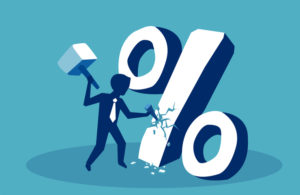If the Fed sticks to its forecast of leaving interest rates at zero for another three years, the U.S. economy will have gone through a 15-year period where interest rates were at zero for about 12 of those years.
What a gut punch to investors in or nearing retirement. The cost of safe retirement income has never been as expensive as it is today. If you want return even if it ends up being ephemeral return, you have to take more risk.
To the Fed’s way of thinking, low-interest rates stimulate economic growth and stoke inflation.
Retired investors be damned!
Yet, since the Fed moved rates to zero, GDP growth has averaged about 1.9% (excluding the massive drop in the second quarter of this year). Inflation by the Fed’s preferred measure has averaged 1.6%. Both are meaningfully below their historical averages.
How do low rates restrain growth and hold back inflation? The problem isn’t necessarily low rates. In the post-WWII era, the Fed dealt with every recession by cutting interest rates which helped the economy recover.
The problem arises with a prolonged period of zero interest rates. Cut rates from 5% to 0% and as soon as rates drop, a whole bunch of pent-up demand is unleashed. Tell the market you are going to leave rates at zero for another five years and after the initial impact there is little additional benefit, but there is a significant cost.
One of those costs is a less vibrant economy. As The Economist explains here, easier access to credit and government support helps keep zombie businesses alive. Yes, zombie businesses employ people, but they lock up capital, lead to excess capacity (holding down inflation), and sap productivity (growth).
The Economist has more on Zombie Businesses (emphasis is ours)
Competition between businesses can deliver vast rewards to the winners, as rich lists dotted with spacefaring billionaires attest. The fate of the losers, on the other hand, is a gruesome demise. At least, that used to be the case. A horde of companies has of late emerged that is neither profitable nor condemned to liquidation or takeover. Such corporate “zombies” stalk the business landscape. They are bad news for the economy. And many more firms are in danger of being zombified during the covid-19 downturn.
Zombie businesses are not a new phenomenon. Marginally profitable firms featured prominently in Japan’s “lost decade” in the 1990s (see article). They have since gained ground in the rest of the world. According to the Bank for International Settlements (bis), a club of central banks, nearly one in six listed firms in rich countries could be classified as a zombie in the run-up to the pandemic, up from around one in 20 in the 1980s (see chart 1). These are defined as firms that fail to generate enough revenue to make their interest payments on borrowings for three years running, and have low valuations that suggest moribund prospects.
Keeping ailing firms chugging along may seem unproblematic: a company need not make profits to keep paying its workers. But the rise in zombies coincides with broader signs of sapped economic vitality. As fewer firms have exited markets, fewer firms have also been created. Younger companies are hiring fewer workers. Employees are moving less, despite technology making it easier for them to find new jobs. Studies suggest that zombification hurts economic dynamism in several ways.
Zombified businesses are found to invest and innovate less than non-zombies. Worse, in some instances zombie firms seem to crowd out healthy ones. Economists at the oecd have found that productive firms in industries laden with zombies find it harder to attract capital. Margins at non-zombies are undercut by firms content to make no return on their investments. Healthy firms invest less as a result. A one percentage-point rise in the zombie share translates into a one percentage-point decline in capital spending by non-zombies, according to the bis. In turn, productivity growth declines by 0.3 percentage points.
Zombification could also have consequences for market competition. Several studies have shown a widening range of productivity performance across firms in the same sector. The dispersion is not solely driven by superstar firms shining more brightly. Studies suggest that the laggards have also stagnated as they have been unable or unwilling to adopt best practices. Markets are less contested, and, in time, deliver lousier service to customers.
Read more here.

